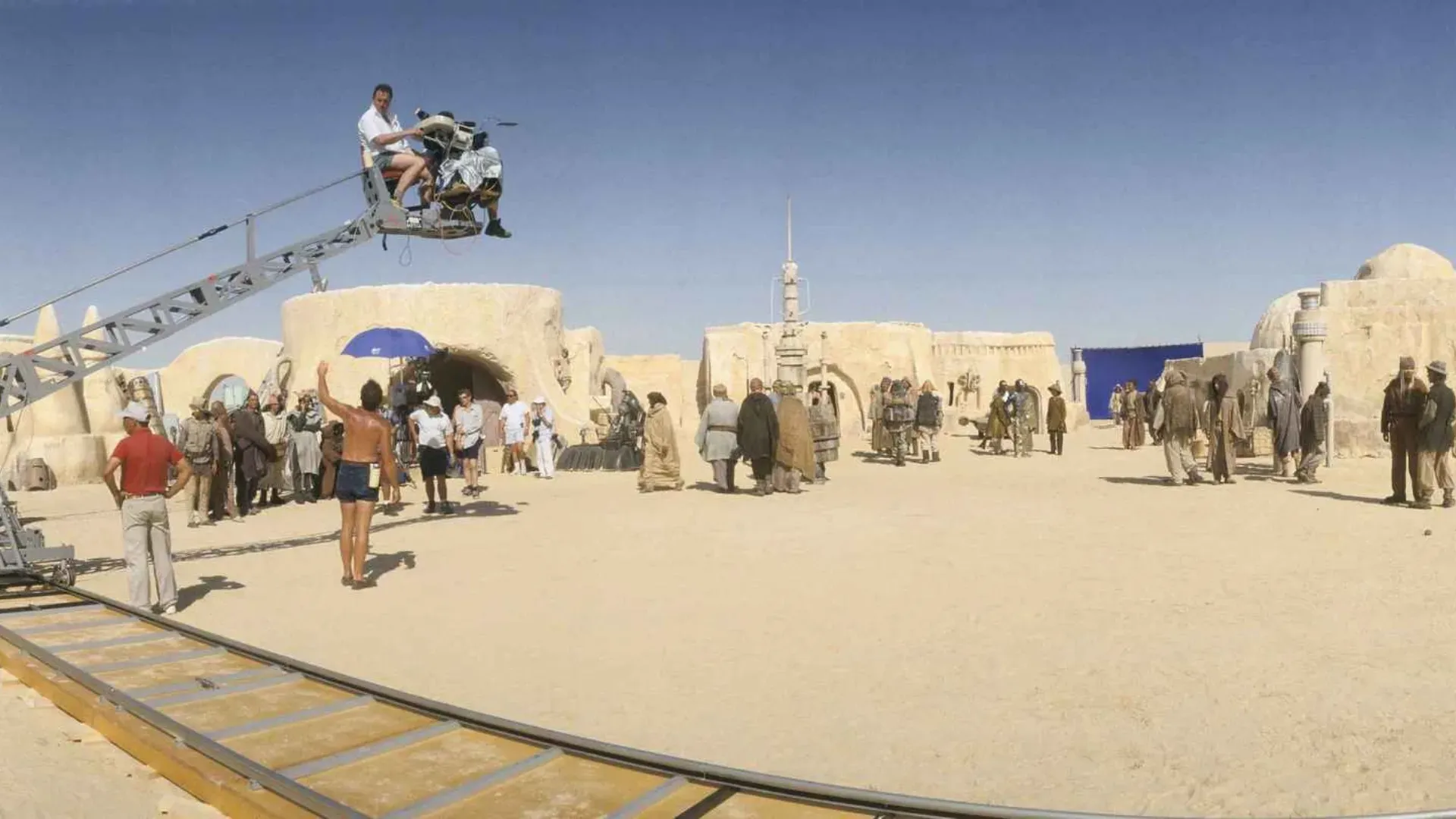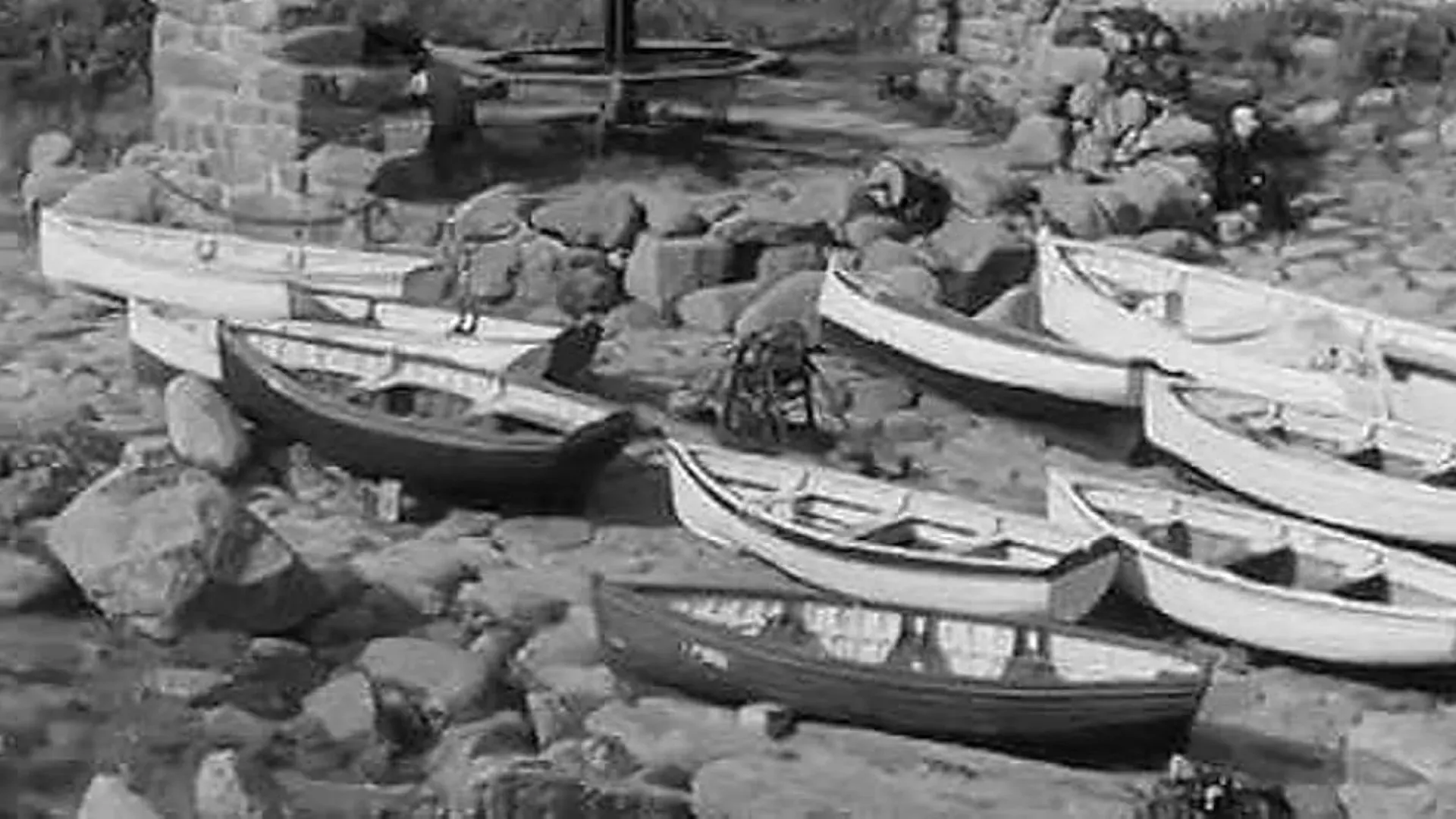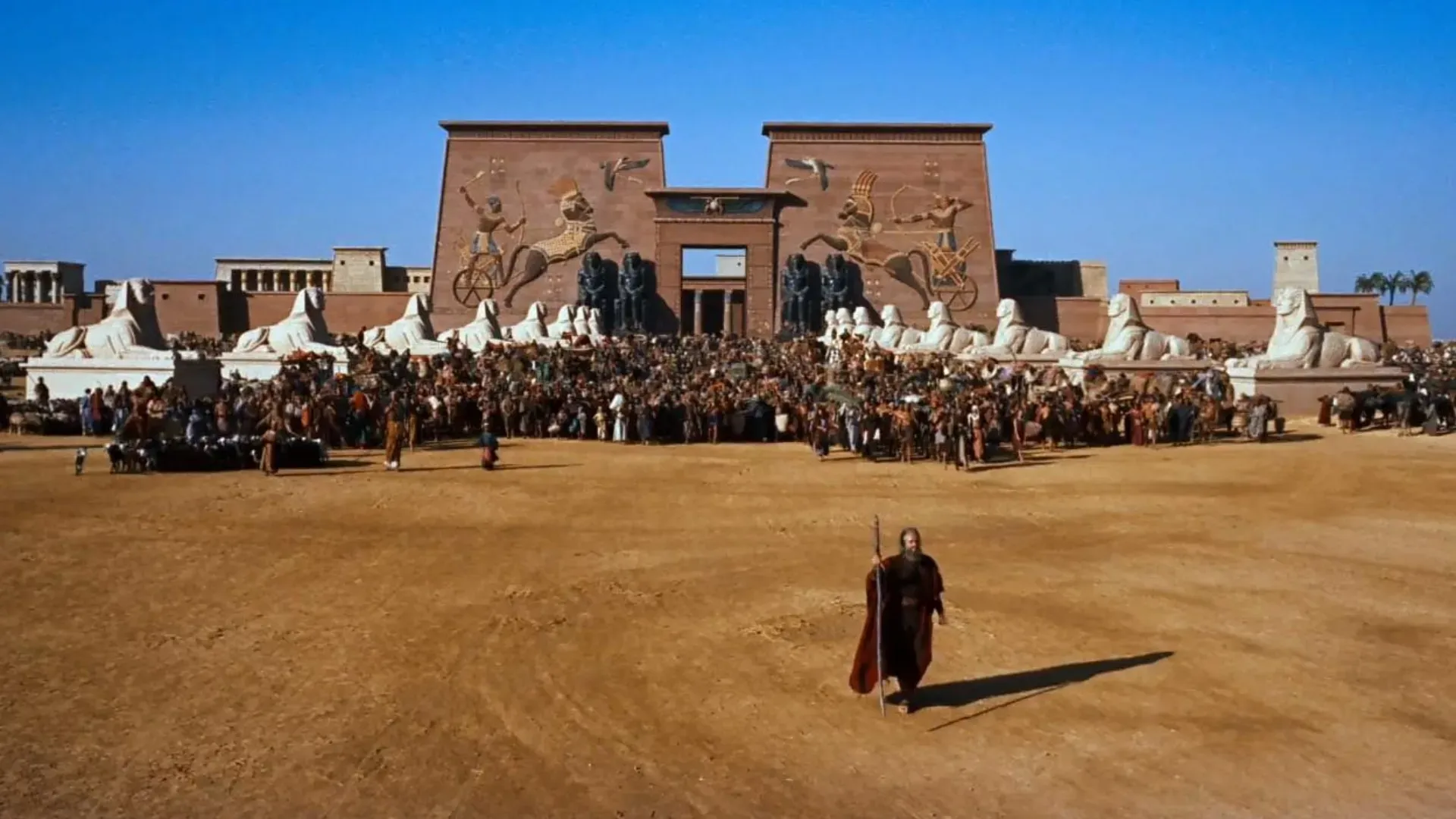Once celebrated on studio maps and tourism leaflets, some of cinema’s most recognizable backdrops now sit in a slow drift toward silence. Sets that once held choreographed chaos, desert outposts built for a single sweeping shot, and entire towns constructed to make fiction feel real have slipped into disrepair after the final slate was clapped.
Production crews moved on; weather and time did the rest. These forgotten corners of film history reveal cracked facades, sun-bleached signs, and the skeletal remains of once-meticulous worlds. Their silent decay underscores an unexpected truth: while movies freeze stories forever, the places that brought them to life often fade more quickly than the memories they created.
Star Wars | Tatooine in Tozeur, Tunisia

(Source: IMDb)
In the vast, untamed desert of southwestern Tunisia, near the arid salt flat of Chott el-Gharsa, stands a monument to cult science fiction. It is not an ancient Berber ksar, but the surreal remains of the spaceport of Mos Espa, Anakin Skywalker’s bustling (and often chaotic) hometown in Star Wars: Episode I – The Phantom Menace.
When George Lucas and his crew left in the late 90s, they abandoned the shell of this city. The bulbous, beige facades of the buildings, hastily constructed for the camera, were not real structures, but mere set pieces. Today, time is not the only enemy; it is geography itself.
Rampant desertification threatens to bury this corner of a galaxy far, far away. Unstoppable dunes advance, slowly covering the sandy streets where Qui-Gon Jinn and Padmé Amidala once landed.
A few kilometers away, another set, the iconic exterior igloo of the Lars homestead (Luke’s childhood home), has been a victim of neglect, remaining abandoned for long stretches and relying on devoted fans for intermittent preservation efforts. The spirit of adventure remains, but the desolation of the desert has claimed its toll, turning fantasy into a hauntingly real landscape of decay.
Pirates of The Caribbean | Port Royale in Wallilabou Anchorage, St. Vincent

(Source: IMDb)
The Caribbean, that region of dreams and legends of buccaneers, was the perfect backdrop for the exploits of Captain Jack Sparrow. Specifically, at Wallilabou Anchorage, on the small, lush island of St. Vincent, the production of Pirates of the Caribbean: The Curse of the Black Pearl (2003) brought to life the bustling yet corrupt British port of Port Royale.
Like many large productions, the filming crew built a full-scale port village. The bay, which was previously a simple fishing stop, was transformed. Period furniture, a rock arch gallows, and colonial buildings were erected over the water. But when the ships sailed for the last time, the set was left behind. More than two decades later, the tropical weather has been brutal.
The wood is rotting, the paint is fading, and most of the sets have fallen into a visible state of disrepair. Despite this, it has become an unusual tourist attraction. Fragments of fiction remain: some remnants of facades, skeletal props, and the unsettling atmosphere of a port frozen in time, awaiting the next major storm or, perhaps, the return of the Black Pearl.
The Hunger Games | District 12 in Henry River Mill Village, North Carolina

(Source: The Hunger Games Wiki – Fandom)
Venturing into the lush forests of North Carolina is the Henry River Mill Village, a place with a real-life history almost as bleak as its role on the big screen. This settlement, which served as the impoverished and coal-stained District 12, the home of Katniss Everdeen, was actually a textile mill town built in the early 20th century.
The village thrived until the cotton mill closed in 1960. Residents left, and by 1987, the last inhabitant had departed, leaving a collection of modest houses and the company store (which became the Mellark bakery) at the mercy of decay.
The pre-Hollywood abandonment is what gave it its authenticity. The directors of The Hunger Games (2012) barely needed to alter the landscape, beyond a few superficial renovations for the Everdeen house.
For years, the property was a safety hazard due to its collapsing buildings. Fortunately, in recent years, new owners have attempted to revitalize the place, offering tours and even restoring some homes as vacation rentals, in an attempt to preserve the history of this ghost town, now immortalized as a symbol of Panem’s oppression.
The Patriot | Old Spanish Mission in Cypress Gardens, South Carolina

Deep in the swampy recesses of Moncks Corner, South Carolina, lies a place of serene natural beauty: Cypress Gardens. However, among its moss-draped cypress trees and murky waters hides an architectural disappointment for the untrained eye: the ruins of an Old Spanish Mission.
This set piece, crucial for the refuge scenes in the war film The Patriot (2000), starring Mel Gibson, does not have centuries of history. It was built entirely as a prop for the Hollywood production. The “ruins” were left behind after the movie wrapped, and the nature park decided to maintain the artificial structure as a peculiar tourist attraction.
The relentless swamp humidity has accelerated its deterioration, ironically giving it the look of the genuine ruin that the production intended to replicate—a vestige of plaster and papier-mâché slowly consumed by the Southern wilderness.
Field of Dreams | Baseball Field in Dubuque County, Iowa

(Source: IMDb)
“If you build it, he will come.” This is the phrase that resonated in Ray Kinsella’s heart and in popular culture. The idyllic baseball field from Field of Dreams (1989), miraculously sprouted from a cornfield in Dyersville, Iowa, is perhaps the most unique preserved set on this list.
The location was built across two neighboring farms for the movie, and once filming wrapped, the original landowners chose to keep their portion of the field, opening it up to visitors. This place was never truly abandoned. The spirit of the movie took hold: it became a pilgrimage site where thousands of fans came annually to “have a catch” and relive the emotional climax of the film.
Although there were periods of conflict between the neighboring owners, the field, house, and atmosphere remained. The narrative of “abandoned” has been reversed: the site has experienced a significant rebirth.
It was sold to an Iowa non-profit organization and has been the subject of massive investment that includes an adjacent professional stadium for the annual MLB games played there, keeping the magic of baseball alive for future generations.
The Lord of the Rings and The Hobbit | Hobbiton in Matamata, New Zealand

(Source: IMDb)
A crown jewel that breaks the rule of abandonment. In the rolling green hills of a sheep farm in Matamata, New Zealand, lies the set of Hobbiton, the quaint home of Bilbo and Frodo Baggins in The Lord of the Rings and The Hobbit trilogies.
Initially, the plan was to dismantle the set after the filming of The Fellowship of the Ring, and much of the first set, built with temporary materials, was indeed torn down.
However, by the time Peter Jackson returned for The Hobbit trilogy, the global popularity of Middle-earth had grown so vast that a monumental decision was made: to rebuild Hobbiton permanently. Now, it is not an abandoned set, but a thriving and meticulously maintained tourist attraction.
The 44 Hobbit holes, the gardens, and the famous inn, The Green Dragon Inn, are now durable structures, accessible only via guided tours. The Shire is the antithesis of abandonment: a movie set that has become a tangible reality, drawing legions of pilgrims and transforming a small farming town into an epicenter of Tolkien tourism. It is the only place on our list where the magic not only survived but was reinforced for eternity.
Popeye | The Coastal Village in Malta

(Source: IMDb)
In 1980, a massive musical production of Popeye, starring Robin Williams, required the construction of an entire fictional settlement: Sweethaven Village. Built on the rugged coast of Anchor Bay in Malta, the set was an incredible feat of design, involving 19 temporary wooden buildings, imported timber, and a complex wooden breakwater to protect the bay during filming.
However, the film was a critical and commercial failure. When production wrapped, the film set was simply left behind. For a time, it stood as a neglected, decaying monument to a Hollywood flop, battered by the Mediterranean sea and sun. Local residents quickly realized the potential of this beautifully crafted ghost town.
Instead of being demolished, the set was resurrected and transformed into Popeye Village, a small, permanent theme park. It is now meticulously maintained, offering boat rides and character shows, having broken free from the decay of cinematic abandonment to find new life as one of Malta’s most peculiar and beloved tourist attractions.
The Ten Commandments | The Unearthed Set

(Source: IMDb)
The search for abandoned film sets can sometimes turn into an archaeological dig. Back in 1923, for his silent epic The Ten Commandments, director Cecil B. DeMille built the largest set in cinema history in the remote dunes of Guadalupe, California. This grand Egyptian city included four massive Pharaoh statues and 21 gigantic sphinxes, with gates reaching heights of 110 feet.
When filming concluded, DeMille decided that dismantling the colossal plaster and wood structures would be too costly and impractical. Instead, he ordered the entire city to be dynamited and buried under the ever-shifting sand dunes, effectively abandoning it by intention. The location turned into a legend: “The Lost City of Cecil B. DeMille”.
In the late 20th and early 21st centuries, archaeological teams began systematic excavations. They successfully recovered large, deteriorated fragments of the massive props, including pieces of the sphinxes and hieroglyphic tablets. These artifacts, now conserved, reveal the extent of the grand cinematic illusion that slept silently beneath the sands for nearly a century, proving the set was literally reclaimed by the earth.
X-Men Series | Hatley Castle in British Columbia, Canada

(Source: Marvel Cinematic Universe Fanon Wiki – Fandom)
On the surface, it is the most recognizable abandoned location on this list—the secretive Xavier’s School for Gifted Youngsters, the magnificent Gothic-style mansion that has served as the headquarters for the X-Men in many of their cinematic appearances.
The reality, however, is far less mystical. The exterior used for the iconic X-Mansion is the historic and stately Hatley Castle in Colwood, British Columbia. Built in 1908, it is neither abandoned nor a school for mutants. It is a highly active and well-maintained National Historic Site that serves as the administrative center for Royal Roads University.
While the castle has welcomed film crews many times for blockbuster shoots, the cinematic magic always fades when the crew packs up. The grand stone structure immediately reverts to its institutional role, leaving no trace of the telepathic professor or the mutant heroes who once trained within its halls.
The Goonies | Principal House in Astoria, Oregon

(Source: IMDb)
The childhood home of Mikey Walsh, the leader of The Goonies, is one of the most recognizable houses in cinematic history. Located high on a hill in Astoria, Oregon, this classic private residence became an unintentional pilgrimage site for millions of fans of the 1985 cult classic.
But the overwhelming love from fans ultimately proved to be the death of the location’s public accessibility. The constant stream of traffic, litter, and noise became intolerable for the residents of the quiet neighborhood. The previous owner was eventually forced to completely close the access road, erecting tarps and signs that effectively turned the house into a visible ghost, hidden from the public by necessity.
While a new fan-owner has since purchased the property with the intent to restore it to its film-perfect appearance, visitation remains strictly monitored and limited to the end of the driveway, serving as a powerful reminder of how excessive cinematic fame can force a beloved location into functional isolation.
The Beach | The Beach in Maya Bay, Thailand

(Source: IMDb)
In The Beach (2000), Leonardo DiCaprio’s character searches for a pristine, untouched paradise—a secret beach unspoiled by human contact. The location chosen for this idyll was the stunning Maya Bay on Ko Phi Phi Leh island in Thailand.
The supreme irony of the film is that its fame led directly to the paradise’s destruction. Following the movie’s release, tourism exploded. The bay was soon inundated by up to 5,000 tourists and hundreds of boats daily. This environmental catastrophe decimated the fragile coral reef and the delicate ecosystem, demonstrating that the magic of the “secret paradise” had died under the weight of mass visitation.
In 2018, Thai authorities took the drastic and unprecedented measure of closing the bay indefinitely for ecological recovery. After years of abandonment by man, nature began to heal. The bay has since undergone a carefully controlled, limited reopening, but the gates to the “untouched paradise” of the film have been permanently closed, preserved now only by strict regulation.
Lara Croft: Tomb Raider Temple | Ta Prohm, Cambodia

(Source: IMDb)
Deep in the sprawling jungle surrounding the ancient city of Angkor Wat lies the temple of Ta Prohm. This 12th-century stone structure was already centuries old and thoroughly reclaimed by the jungle when it served as the set for Lara Croft: Tomb Raider (2001).
It was the perfect backdrop for the intrepid archaeologist: a site where enormous strangler fig and silk-cotton trees embrace the crumbling stonework, their roots threading through the temple walls like the tentacles of an ancient, earthen kraken.
Unlike other sets constructed for cinema, Ta Prohm was embraced by Hollywood because of its dramatic decay. The temple is not abandoned in the traditional sense; it is a UNESCO World Heritage Site under constant, careful preservation. However, its magic lies in its state of eternal ruin—a stunning monument left in beautiful, deliberate chaos.
While tourists now flock to see the “Tomb Raider Tree,” the atmosphere remains one of profound age and quiet abandonment, where the jungle is the primary architect and time the undisputed master.
Into the Wild | Kennecott Mines in Alaska

(Source: IMDb)
The film Into the Wild (2007) is a haunting ode to extreme isolation, centered on the fate of Christopher McCandless in the Alaskan wilderness. While the iconic “Magic Bus” where he met his end was relocated for safety, the spirit of genuine, raw abandonment is perfectly embodied by the Kennecott Mines complex in Alaska, where the film was partially shot.
This was once a thriving copper mining town in the early 20th century, producing vast wealth. But when the ore ran out in 1938, the entire population was given two days’ notice to evacuate. They left everything behind: the massive wooden mill buildings, the hospital, the residential camp—all untouched.
Today, Kennecott stands as an authentic ghost town, preserved by the subarctic climate. The enormous mill buildings cling precariously to the mountain slopes, a skeletal testament to human industry swallowed whole by the vast, indifferent landscape.
The location perfectly channels the themes of man versus wilderness that defined the movie, making the true ghost of Kennecott just as compelling as the film’s narrative.
Big Fish | Town of Spectre in Montgomery, Alabama

(Source: IMDb)
Few movie locations are as deliberately fantastical as the town of Spectre from Tim Burton’s Big Fish (2003). In the film, Spectre is a utopian, shoe-free town where life is permanently perfect—that is, until it is visited decades later as a dilapidated, moss-covered ruin.
To achieve this, the entire fictional town was built as a working set on a small, marshy island in the middle of a lake near Wetumpka, Alabama. When filming finished, the set was partially left standing. Instead of being completely demolished, the wooden facades, the general store, and the distinctive main street were left to rot.
Today, Spectre is a decaying relic, slowly sinking back into the swamp from which it was born. While sometimes accessible via a rustic wooden bridge, the buildings are heavily weathered, collapsing, and covered in green moss, having been reclaimed by the nature that surrounds them, mirroring the decaying dream world depicted in the final act of the film.
The Hills Have Eyes | The Gas Station in Ouarzazate, Morocco

(Source: IMDb)
The city of Ouarzazate is known as the “Hollywood of Morocco,” a sprawling desert hub for international film production. It was here, in the harsh, rocky terrain outside the city, that the gruesome gas station and diner set for the 2006 remake of The Hills Have Eyes was erected.
This location was the stage for the film’s unsettling opening act and was crucial to establishing the atmosphere of utter desolation. Like many temporary sets in this region, the gas station was never designed to last. Once the screams and the cameras faded, the production crew departed, leaving the fabricated structure to the mercy of the elements.
Today, the set stands as a forgotten piece of cinematic debris—a dilapidated wooden frame and faded sign slowly being sandblasted by the relentless Saharan winds. It’s a silent, eerie ghost, confirming that in the Moroccan desert, man’s structures are always temporary, and abandonment is inevitable.





